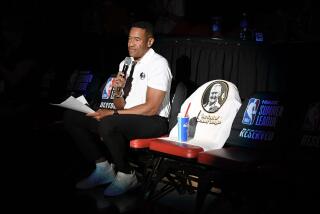Newell was the Big Man
- Share via
Basketball has known all sorts of great coaches: from the magnificent purists such as Dean Smith, Larry Brown and Mike Krzyzewski, to the warrior-kings Bob Knight and Pat Riley, to the philosopher-king Phil Jackson.
There were three, however, unlike anyone before or after, with personal values as important as their accomplishments.
One is UCLA’s John Wooden, whose records will never be approached and whose spirit would inspire his players long after they were through playing.
One was the Boston Celtic Godfather, Red Auerbach, who built the NBA’s greatest dynasty, and longest-running extended family, on street smarts and will.
The third was Pete Newell, who died last week at 93.
Newell’s accomplishments -- an NCAA title at California in 1959, an Olympic gold medal in 1960 with the Dream Team of its time -- were impressive, but his impact went far beyond that.
Gentle, unassuming and without an ounce of self-promotion, Newell crossed over into professional basketball, casting a long shadow over both worlds.
He was the coaches’ coach, shaping generations of players at his Big Man’s Camp, serving as surrogate father to greats as disparate as Jerry West, the NBA’s Logo, and Knight, the college game’s winningest coach.
Appropriately, Newell died at a friend’s home in Rancho Santa Fe, waiting eagerly for the arrival of an old friend.
It was West, working on a new book and eager to introduce his co-author to Newell, who, as Lakers GM, had talked him off so many ledges at the end of his playing days.
Driving down from Los Angeles, West arrived a few minutes late, to find Newell had died, only minutes before.
“I got distracted and I went by the exit,” West said. “I missed it by two exits, so I turned around and came back. . . . I went through the gate and they were standing on the porch with tears in their eyes.
“He had just passed away. I missed him by about two minutes. I walked in there and he was sitting there in a wheelchair. I walked over there and put my arm on his shoulder and said what I thought should be said, to myself. . . .
“He and I were probably a lot closer than people thought. He really meant a lot to me. He was very much of a father figure for me.
“He knew how I blamed myself for losses, not anyone else, and he was always there to kind of put a hand on my shoulder and say, ‘Hey, look, you couldn’t play better.’
“And I’d try to explain to him, maybe I couldn’t play better, but we didn’t win.
“He seemed to understand that part of me when I’m not sure, even today, I understand it.”
Newell retired from coaching after the 1960 Olympics (West was on that team), became Lakers GM and scouted for several teams, but it was his Big Man’s Camp that brought successive generations to him.
Held at Inglewood and Westchester high schools, at Stanford and in Honolulu before settling in Las Vegas, the camp started when Newell worked with two players, the Lakers’ Kermit Washington and UCLA’s Kiki Vandeweghe.
Washington was a fearsome but untutored power forward. Vandeweghe was going from UCLA to the NBA but had some things to work on -- or, as he puts it, “I couldn’t get a shot off.”
Thirteen years later, Vandeweghe retired from the NBA with a 19.7 career average and a 53% shooting percentage, having learned a trick from Newell that everyone now uses: the step-back.
Vandeweghe says Newell got the idea, watching him play against Washington, whom he was always bouncing off.
Stu Lantz, the Lakers broadcaster who was Newell’s right-hand man at the camp for the last 20 years, estimates that of the big men who had success in the NBA, 90% attended the camp.
“After a while, a lot of teams started sending coaches with their players to observe,” says Vandeweghe, now the New Jersey Nets’ GM. “Then when the players went back, the teaching continued.”
Hakeem Olajuwon, the ballet dancer of the pivot, attended. So did Shaquille O’Neal, before his first two seasons when the other campers watched wide-eyed.
“I can remember his first camp at Westchester,” Lantz says. “There was a photographer rigging a camera to the backboard. I told him that wasn’t going to work because of the way Shaquille dunked.
“He said, ‘It’ll be OK.’ Sure enough, it came down.”
When O’Neal came back the next summer, another camper, Sam Perkins, was asked why O’Neal was there.
“Damn if I know,” Perkins said, laughing.
Newell had a lot of surrogate sons but none closer than Knight, who, for all his ferocity, revered the great coaches of the past like Clair Bee, but Newell most of all.
Knight included Newell in everything, asking him to address his teams, putting him on his Olympic staff in 1984, even as he set out to supplant Newell’s 1960 team as the greatest ever.
Of course, Pete being Pete, he said that Bob’s team had done just that as soon as it won its gold medal.
Knight and West talked on the telephone shortly after Newell died, Knight noting later it was “a very tearful conversation.”
We call a lot of things “great,” but if you want to know what real greatness is, the devotion Newell tendered and received was it.
--
More to Read
All things Lakers, all the time.
Get all the Lakers news you need in Dan Woike's weekly newsletter.
You may occasionally receive promotional content from the Los Angeles Times.






